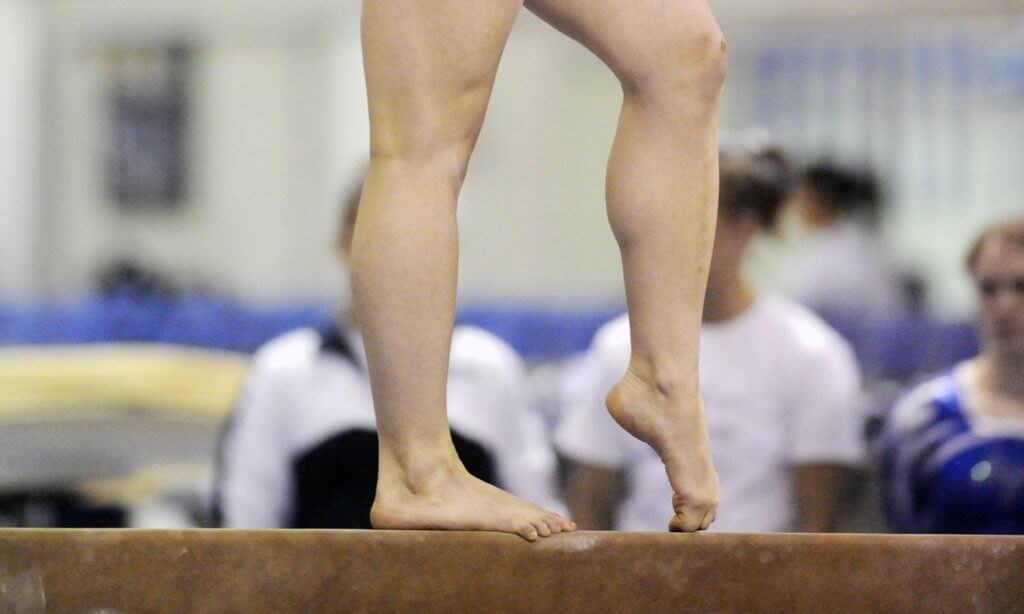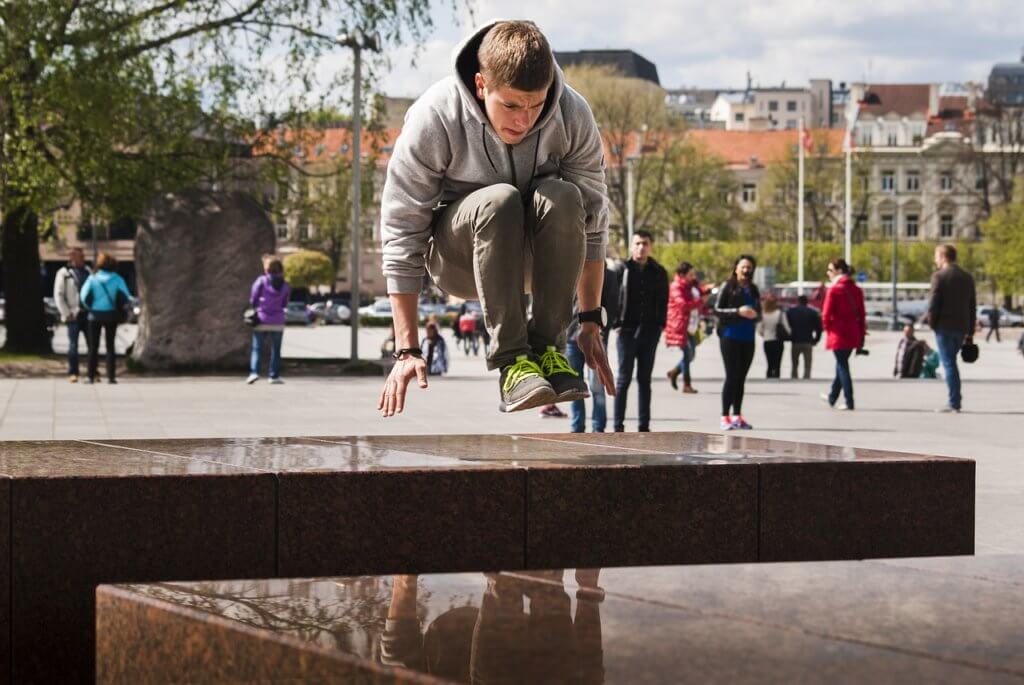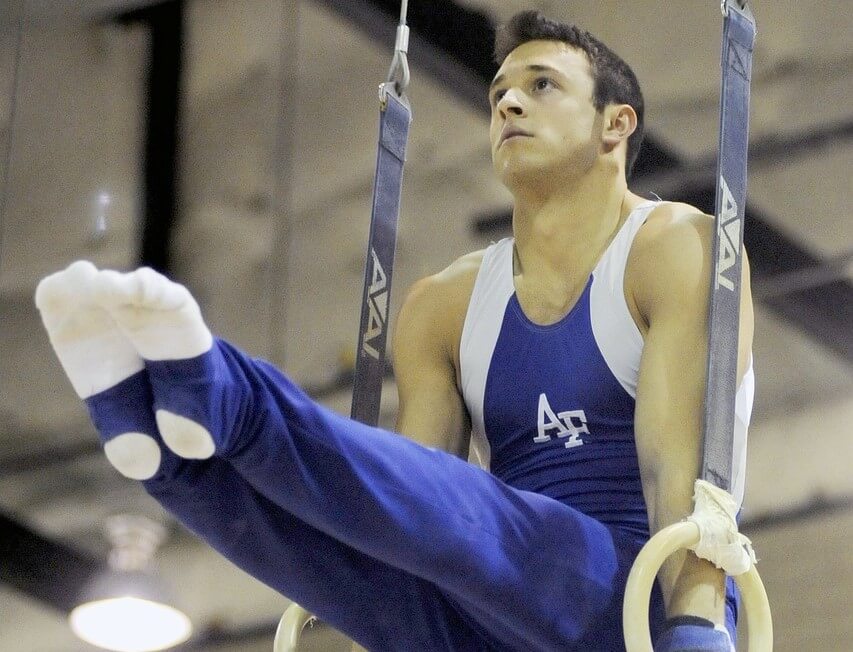The benefits of gymnastics are all-encompassing, and are felt by recreational and competitive gymnasts alike. When an athlete learns gymnastics, they’re developing both their body and mind. These benefits carry over into their emotional well-being and sense of self-confidence.
As developers of gymnastics club software, we’re interested in understanding all the benefits of gymnastics. That’s why we decided to create a definitive list of all the sport has to offer. If you think we missed anything, get in touch and let us know on Twitter!
To begin, let’s start with one of the most undeniable benefits of gymnastics; improved athleticism.
1) Gymnastics Produces The Most Athletic Athletes
There are clear benefits of gymnastics for other sports. It’s a commonly held belief that if you were to swap athletes across a variety of sports, gymnasts would perform best along the spectrum.
At the height of his career, UFC Champion George St. Pierre expanded upon this idea, saying “nobody can reproduce the movement of gymnastics guys, but gymnastics guys can reproduce the movement of everyone. They’re the most athletic athletes in the world.” That’s why George St. Pierre practiced gymnastics throughout his professional fighting career.
Of course, anyone practicing gymnastics will see its benefits, not just professionals. Why? Because it’s a holistic physical development that sets gymnastics apart.
Let’s dive into some of the specific physical benefits of gymnastics, below.
2) Gymnastics Teaches Balance
Balance is fundamental to every single sport you can play, and it’s one of the many physical benefits of gymnastics.
Outside of organized sports, balance is also integral for many childhood activities. From learning to ride a bicycle to climbing into a tree fort, when a child has a good sense of balance, they can safely and confidently participate in a wide variety of activities. This participation can then help children develop their social skills.

These interpersonal benefits stem from children developing good balance, but of course, there’s a clear physical benefit as well. When children have a good sense of balance, they are less likely to fall.
One of the benefits of doing gymnastics at a gym, is that there’s always a coach around to spot a child on equipment. However, that’s not the case outside of the gym.
If a child falls on their bike or when trying to climb into a tree house, they could end up with a serious injury. But, by arming children with a better sense of balance, gymnastics is able to help children prevent some of these painful falls.
Furthermore, there’s a major long-term value in maintaining a good sense of balance. Not only does maintaining a good sense of balance help prevent falls in the elderly, it also helps them maintain confidence and independence. Clearly, this is a major benefit of gymnastics for adults, but we can’t undervalue the impact of starting early.
When children develop a good sense of balance through gymnastics training, parents are setting them up with the opportunity to maintain good balance throughout their lifetime.
3) Gymnasts Experience Major Improvements in Flexibility
As gymnasts continue to practice skills such as straddles, splits, pikes, cartwheels and more, their flexibility increases. This increase in flexibility helps further protect gymnasts from injury, especially when playing other sports.
For example, a fall that occurs at high speeds can be very difficult to properly absorb. If an athlete who’s trained in gymnastics happens to take a tumble on the ski hill or at the hockey rink, increased hip abductor, hamstring or quad flexibility can help prevent painful muscle pulls.
If he average hockey player gets tripped up and falls awkwardly into the splits, they might end up with a pulled groin. For a gymnast, however, the splits are a familiar position. Although its not the desired position to be in on the ice, a gymnast is much more likely to be able to get back up and continue playing without an issue.
Of course, a gymnast’s increase in flexibility isn’t just valuable for injury prevention, it’s also a performance enhancer outside the gym! When you can move in ways that others cannot, your flexibility becomes a competitive advantage.
Soccer legend Zlatan Ibrahimovic showcased his flexibility and coordination with his 500th goal. Throughout his career, his flexibility was a competitive advantage on the soccer pitch.
4) Coordination is Perfected with Gymnastics
Numerous sports help children develop coordination. However, gymnastics takes this development to a whole new level. In gymnastics, the gymnast is required to control complex movements from unfamiliar positions.
Take the ‘skin the cat’ movement on the rings. When the gymnast is upside down, they’re asked to point their toes, keep their legs straight, flexed, and together, and then slowly rotate out of the inverted position using shoulder and core strength. That’s a lot to think about when you’re hanging upside down!
Needless to say, the move is quite complex. Yet, most beginner gymnasts will grow to master it in a short amount of time. These practices improve a child’s focus and mind-muscle connection which helps them learn to control their body in a more coordinated way.
As gymnasts continue to progress, so does their complex motor skills development. For example, a competitive trampoline gymnast gains expert understanding of their movements. They know that they can add twists to their layout by simply dropping one arm. As their body gets used to the feeling, they can add more momentum to the movement of their arms in order to gain more twists.
These types of movements, and this degree of coordination will be completely unknown to most people, but for gymnasts it’s all part of training.
5) Gymnasts Learn How to Avoid Injury
We’ve already touched on the natural benefits of gymnastics in allowing athletes to better absorb or avoid falls. However, gymnastics training goes even further.
Athletes who train in gymnastics learn how to fall so that they can avoid injury. Whether it’s through practicing prone falls, log rolls, shoulder rolls, dive rolls or other gymnastics skills, practicing gymnastics helps train an athlete to absorb and redirect energy to prevent injury.
These skills are so effective that high impact sports like parkour have picked up elements such as the shoulder roll in order to redirect the body’s force when completing big jumps.

Combine these skills with a gymnast’s increase in flexibility, and there’s no doubt that one of the biggest benefits of gymnastics can be injury avoidance.
6) Gain Full-body Strength with Isometric Training
Training for gymnastics requires intense isometric strength. As athletes train their skills across various apparatus, they’re required to support their body weight in an array of complex positions and movements.
This training helps develop both minor and major muscle groups in order for gymnasts to stabilize and control their movement. As a result, unlike many sports that strengthen certain body parts while ignoring others, the gymnast gains full-body development.
With this full-body development, gymnasts are able to move with explosive power and control.
Above: Canadian gymnast Kyle Shewfelt showcases power and control, capturing Gold at the 2004 Olympic Games in Athens.
7) Gymnastics Teaches You How to Achieve your Goals
Gymnastics isn’t easy. It takes a lot of hard work and training to master each skill as a gymnast advances through their programming. It’s inevitable that a gymnast will become stuck at some point during training. However, it’s during this struggle that some of the greatest personal growth occurs.
When a gymnast struggles to master a new skill, they begin to learn what it takes to succeed.
Ultimately, struggle creates an opportunity for goal setting. With the help of coaches, a gymnast can learn to set S.M.A.R.T. goals to help them further their practice. These are goals that are specific, measurable, achievable, relevant and time-based.
For example: A gymnast and their coach could set a goal for the gymnast to master their back walk-over by the end of the season. Using the S.M.A.R.T. framework, they could ensure it’s achievable in this way:
Specific: The goal is to master one skill, the back-walkover.
Measurable: The gymnasts’ coach can confidently assess the gymnast’s skill and measure their success.
Achievable: The coach must believe the back-walkover is achievable based on the gymnast’s skill set.
Relevant: The back-walkover must be relevant to the group of skills the gymnast is learning.
Time-based: The goal must be achieved by the end of the season.
By using the S.M.A.R.T. framework and working diligently to practice and perfect their new skill, this gymnast can not only master their back walkover, but also learn the importance of goal setting and achievement.
This achievement helps gymnasts build self-confidence that extends outside the gymnasium.
8) Self-confidence: A Mental Benefit of Gymnastics
Sometimes when we think of confidence, we may think of someone who doesn’t appear to be phased by criticism. While some might think that this is just a natural gift, or a characteristic only available to the headstrong, that’s not true.
An important part of building self-confidence is getting comfortable with receiving and implementing criticism.

When a gymnastics coach delivers constructive criticism about how a gymnast can master a new skill, the gymnast learns how to receive that information. Specifically, the gymnast learns that it’s okay to be told “you didn’t get that right.”
So, instead of criticism being unbalancing, gymnasts learn that criticism is part of the process of achieving your goals. More importantly, they walk away with confidence knowing that they can use it as a tool to grow!
9) Building Social & Problem-Solving Skills
The process of goal setting and achievement requires a gymnast to sharpen their social skills. When things aren’t going as planned, they learn to ask questions about how to improve. As mentioned above, they learn to seek out constructive criticism, listen closely to that advice and implement the changes.
This is an ongoing process that may require several cycles of question, answer and implementation. As a gymnast repeats these cycles, their ability to socialize and problem solve is improved upon again and again. These problem-solving abilities can then extend into other areas in life.
10) Gaining Improved Posture from Improved Strength
As we’ve mentioned, isometric strength training in gymnastics leads to full-body strength development. As a result, children are more likely to have the strength to exhibit good posture.
Sitting at a school desk all day, can cause some children to develop bad habits. If they do not have the strength to comfortably support their frame, they may slouch and put strain on underdeveloped parts of their back. This habit can lay the foundation for repetitive strain injuries later in life.

When a child has the strength to support good posture, however, they can easily avoid these bad habits. Furthermore, when they carry themselves with the proper posture, they’re able to approach new physical activities in a safe way.
Even activities as simple as running become much safer when a child exhibits good posture.
11) Disease Prevention & The Health Benefits of Gymnastics
The health benefits of gymnastics are plentiful. Introducing children to the joy of gymnastics helps reduce the barrier to entry for other activities. Because when kids feel confident in their physical abilities, thanks to improved coordination, balance, and strength, they’ll be more likely to join in other sports.
All of this physical activity helps develop good cardiovascular health, muscular strength and even bone health. Just as important, these activities also help fend off the negative health consequences of a sedentary lifestyle.
The heart and stroke foundation estimates that being physically inactive increases your risk of stroke and heart disease by a whopping 50%! Similarly, the Canadian diabetes association says that regular exercise can delay, and even prevent type 2 diabetes. Lastly, the American Cancer Society found that regular exercise is linked with lower risk of 13 types of cancer. These three examples clearly prove the importance and benefits of kids getting active.
12) Building Life-Long Friendships
One of the great benefits of gymnastics is the friendship gymnasts can build. Whether standing in line at the vault, or stretching during cool down, gymnastics provides opportunities for athletes to get to know each other and form a bond.

As gymnasts work toward achieving their goals, they learn to celebrate the success of their friends, as much as their own. This type of friendship and compassion was front and center at the Rio Olympics.
As we mentioned in our article about the lessons we can learn from Simone Biles, Simone was ecstatic about her teammate’s silver medal, after all the hard work she put in. Simone was so happy, in fact, that she said she was prouder of her friend’s accomplishment than her own gold medal win!
Of course, the more intensive the practice and training, the closer gymnasts become. As Olympic gold medalist Amanda Borden said, about her training experience, “The people you’re surrounded by really become your second family, your best friends, your sisters. My coach was like a second mother for me.”
Whether a gymnast is just starting recreational gymnastics, or training for competitive, the bonds formed from practicing with friends can last a lifetime.
13) Gymnastics is Fun!
When it comes down to it, what’s more fun than learning to soar through the air?
Whether you’re jumping on the trampoline, mini tramp, beat board, tumble track, or tumbling on the floor, gymnastics teaches you to harness your power and fly.
As every personal trainer will tell you, exercise needs to be enjoyable. The more fun you have, the more likely you’ll make it a habit. When you’re learning new skills and achieving your goals with friends, it’s fun to stay active with gymnastics!








